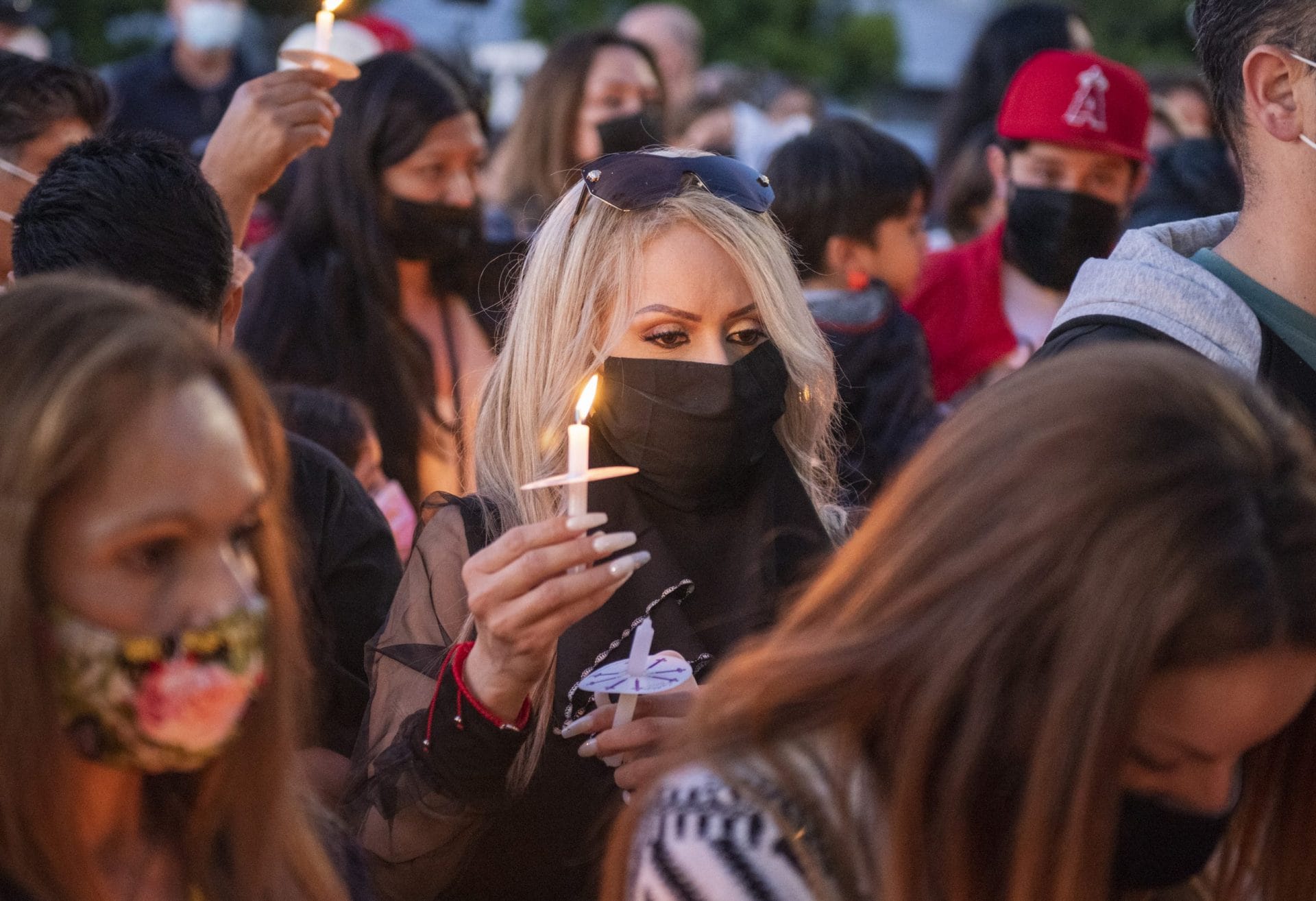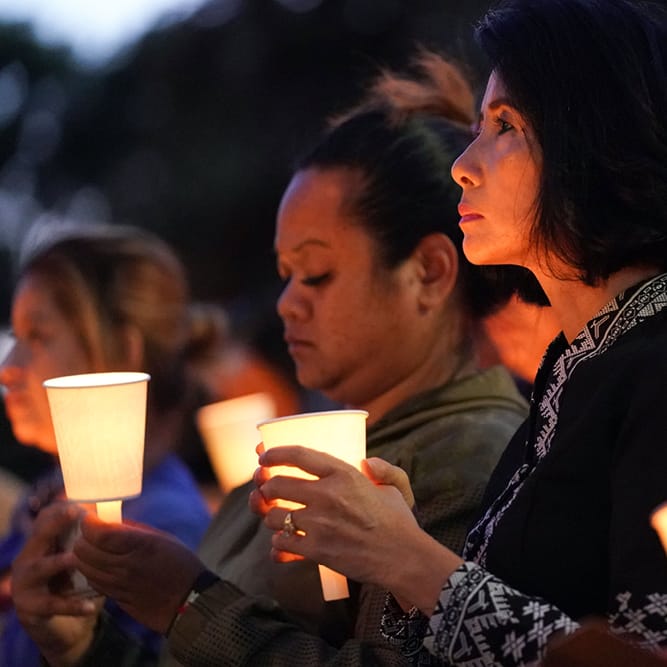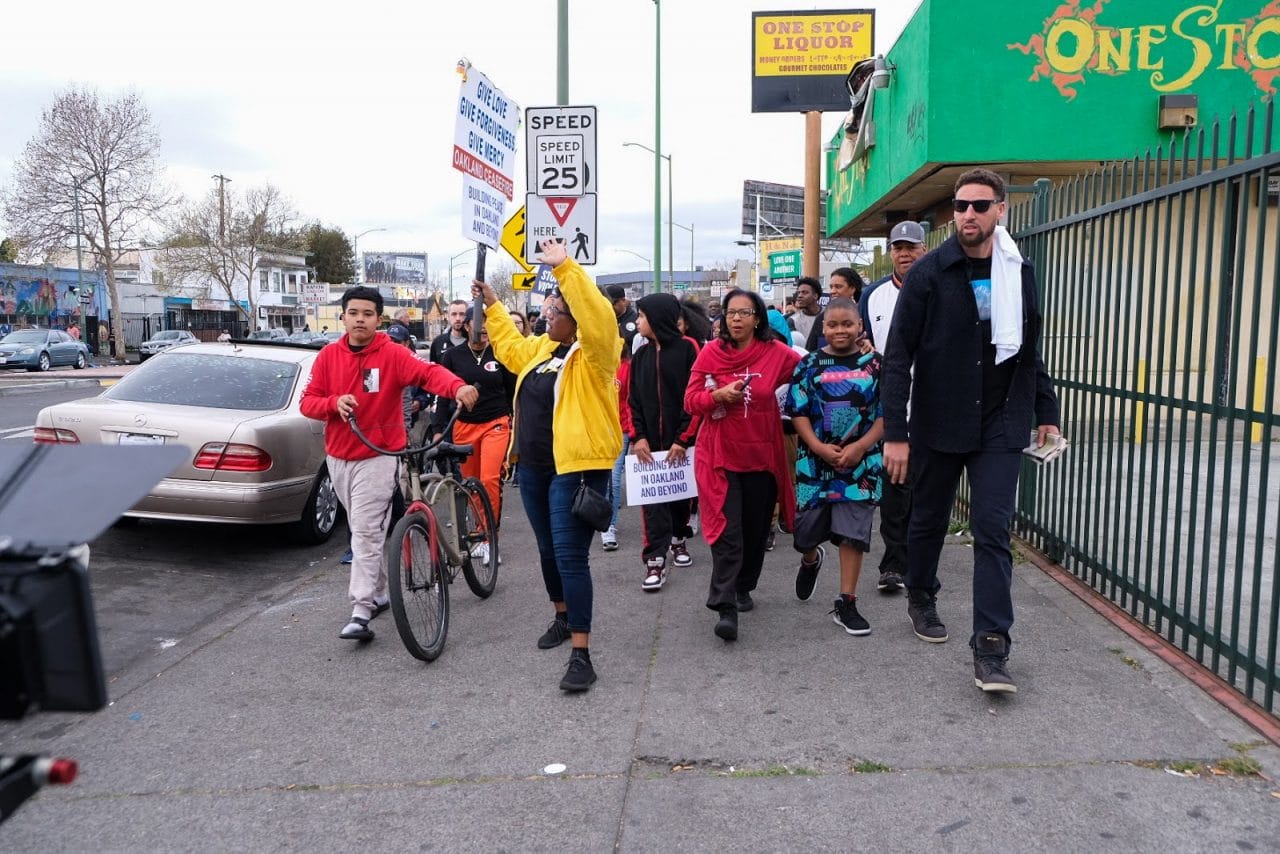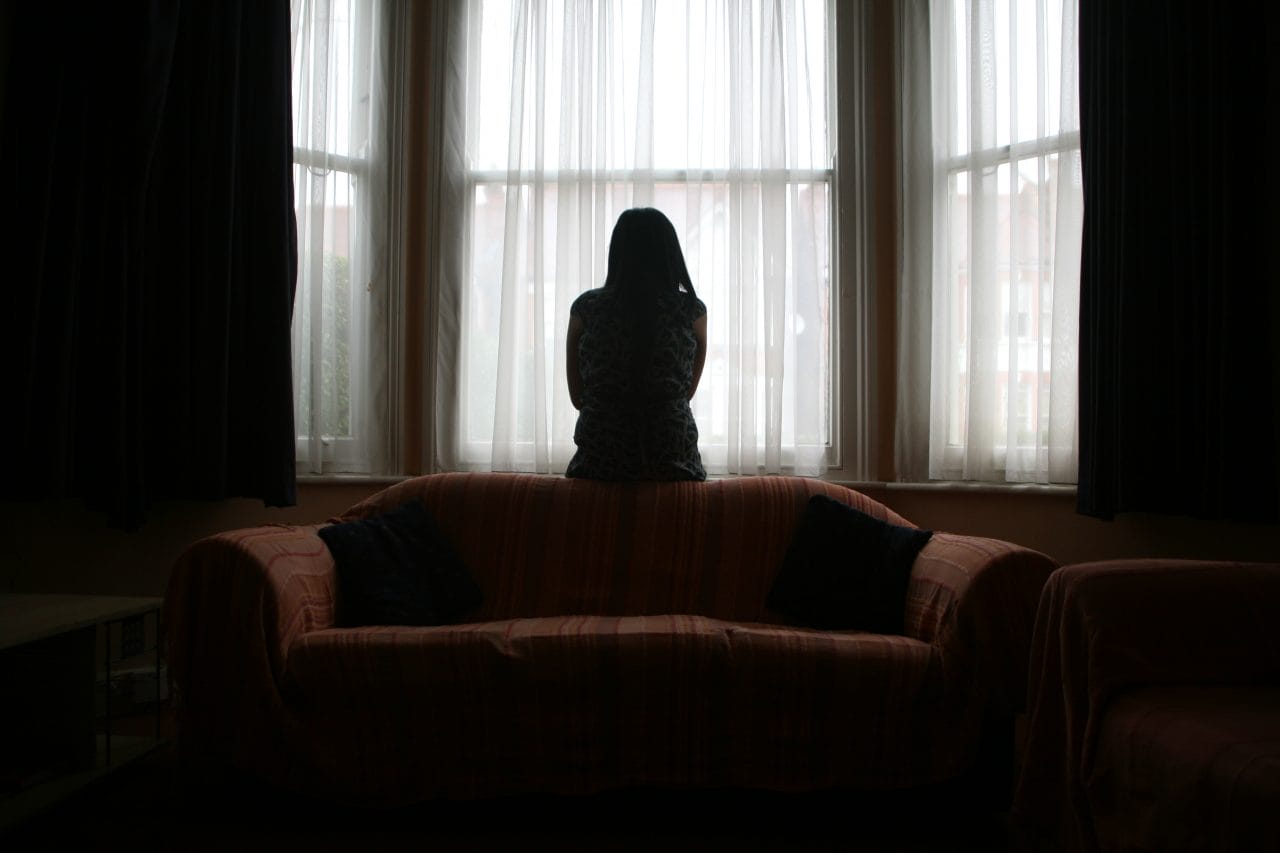
COVID-19 & Gun Violence: Intersecting Epidemics
Over the past year, the COVID-19 pandemic has upended life as we know it and caused incalculable trauma and loss.
As of April 1, 2021, there have been nearly 30.5 million confirmed cases of COVID-19 in the US, and more than 550,000 Americans have died from the virus.1 This public health crisis has collided with and exacerbated another major public health crisis plaguing our country: gun violence.
This week, Giffords is unveiling a Gun Violence Memorial on the National Mall in Washington DC as a tribute to the nearly 39,000 Americans who die from gun violence each year. The installation was designed by the same artist who created the COVID-19 memorial, and is meant to visualize the scope of the crisis while encouraging Americans to urge their elected representatives to take action to end gun violence.
Fortunately, we’re already seeing promising signs of federal progress. Last week, President Biden announced a series of executive actions from the White House Rose Garden, including commencing a rulemaking process on untraceable and undetectable “ghost guns” through the Department of Justice and allocating investments to lifesaving community violence intervention programs.
Last month, the House of Representatives passed a series of gun safety bills, including legislation to enact universal background checks, address the Charleston Loophole, and prevent individuals convicted of stalking and dating partner abuse from accessing guns. As the below memo outlines, there’s no time to waste in taking action to end this crisis.
MEDIA REQUESTS
Our experts can speak to the full spectrum of gun violence prevention issues. Have a question? Email us at media@giffords.org.
Contact
Overview
Because of how data on gun deaths and gun violence are collected in our country, we are still waiting for a full picture to emerge of how the pandemic and the measures taken to slow its spread have impacted rates of gun violence. But preliminary data and early estimates are grim, suggesting that 2020 ended with a gun death rate far higher than seen in recent years. Alarmingly, this trend appears to be persisting into the early months of 2021.
The Centers for Disease Control and Prevention (CDC) recently released preliminary estimates for firearms mortality through June of 2020. This new data shows that from April through June of 2020, the rate of firearm death was 10% higher than during this same period in 2019.2 This increase appears to be driven primarily by an increase in homicides, as total homicides increased by nearly 27% during this same period compared to 2019.3
Amidst these increases, we have also seen record-breaking firearm sales, with an estimated 22 million guns purchased in 2020—an increase of nearly 65% over previous year sales.4 Data from January and February 2021 suggest that surges in gun sales have persisted into this year.4
In fact, the FBI conducted more than 4.3 million gun background checks in January 2021, the highest number of checks completed during a single month in the agency’s records.4 While more research is needed to measure the impact of surges in gun sales on gun violence in 2020, previous research has found that surges in gun purchasing after mass shootings or presidential elections have resulted in increases in gun violence,5 and new research suggests that increased gun sales in March and April 2020 similarly led to increases in gun violence.6
Gun violence hurts our communities in many ways, from community violence to domestic violence to firearm suicide. The below data outlines how each of these forms of gun violence was exacerbated by the pandemic and other events of 2020.
Community Gun Violence
In March 2020, when many states and communities implemented stay-at-home orders, there was some hope that community violence and violent crime would decrease with more people staying home. While crime generally decreased in 2020, unfortunately, gun violence in cities persisted and, in many cases, increased. Critically, violence intervention workers around the country continued to mediate and reduce conflicts even while their funding was often threatened, while also pivoting to distribute masks, hand sanitizer, and public health information to vulnerable populations.
Both the pandemic and high-profile incidents of police brutality left communities more vulnerable to gun violence in 2020.
- Many of the communities that experienced the greatest burden of COVID-19 infections and deaths have historically experienced the highest rates of gun violence. For example, data suggests that Black Americans were nearly twice as likely to die from COVID-19 as white Americans in 2020,7 and historical data shows that Black Americans are 10 times more likely to be killed in a gun homicide compared to white Americans.8
- Black communities have also disproportionately experienced the negative economic impacts of the pandemic. Black Americans—and Black women in particular—experienced the largest drops in employment in its early phase.9 Chronic high levels of unemployment can increase community-level risk for gun violence; research shows that counties with high unemployment and high rates of poverty have higher rates of gun homicides and shootings.10
- Furthermore, highly publicized incidents of police brutality after the deaths of George Floyd, Breonna Taylor, and many others deepened distrust between communities of color and police. Research has shown that when police-community trust erodes after incidents of police brutality and misconduct, communities may be less likely to rely on police to solve disputes, increasing the chance of retaliatory violence.11
Data from many local police departments shows large increases in gun violence in 2020, and early evidence indicates this trend has persisted into 2021.
- FBI preliminary statistics show a major increase in murders last year, with a 25% rise among agencies that reported quarterly data.12 Importantly, the FBI data indicates that not only were these increases seen in large cities, but mid-sized and small jurisdictions saw increases in homicides as well.12
- In 47 of the 50 largest cities with available data, homicides rose by an average of roughly 35% from 2019 to 2020.13 In total, these increases led to nearly 1,800 additional homicides across just these 47 cities. Milwaukee, Wisconsin, saw a more than 100% increase in homicides in 2020 over the past year, and eight additional cities—Mesa City, AZ; Louisville, KY; Seattle, WA; Minneapolis, MN; Columbus, OH; Fresno, CA; Phoenix, AZ; and Fort Worth, TX—saw increases in homicide of more than 60% over the past year.14
- Nonfatal shootings are also on the rise. In eight of the 50 largest cities that provide up-to-date nonfatal shooting data, the number of nonfatal shooting victims was up roughly 60% in 2020 compared to 2019.15 These increases led to nearly 4,000 additional shooting victims in just these eight cities in 2020 compared to 2019.15
- Many cities saw levels of gun violence in 2020 they hadn’t experienced in years. Louisville, Kentucky’s Metro Police Department recorded the highest-ever number of homicides in 2020—exceeding the 2016 record by 56 homicides.16 Milwaukee, Wisconsin saw nearly 200 homicides in 2020, breaking the record set in 1991.17
- Alarmingly, the increases in violence observed in 2020 have persisted into the first months of 2021 in many cities across the country. For example, nonfatal shootings are up nearly 47% in New York, NY; 39% in New Orleans, LA; 37% in Philadelphia, PA; and 24% in Chicago, IL, in the first three months of 2021 compared to the same period in 2020.13
Domestic Violence
Domestic Violence
The combination of intimate partner violence and access to guns is an especially deadly mix.
During the past year, victims of domestic abuse have faced increased risks associated with stay-at-home orders and pandemic-related economic impacts. Firearms significantly compound these risks: when an abusive partner has access to firearms, a victim of domestic violence is five times more likely to be killed.18
The measures used to control the spread of the pandemic, as well as many of the ripple-effects of the pandemic, have exacerbated the risk of violence in the home.
- Lockdowns and stay-at-home orders have isolated some victims in close proximity to abusive partners. These orders have also limited access to victims’ services groups and other members of the community who may have noticed and reported signs of abuse or intervened to help victims escape violent situations.19
- Increased unemployment related to closures of businesses can also worsen the risk of domestic violence. Male unemployment in particular has been shown to be a significant predictor of domestic abuse.20
- The economic impacts of the pandemic may have also increased the risk for abusive and controlling behaviors. Multiple studies have found economic vulnerability, employment instability, and perceptions of economic strain at the individual level are associated with domestic abuse.21 During the Great Recession, abusive behavior increased in families most adversely impacted by the worsening economy.22
- Poor coping strategies with the pandemic and social isolation, including the increased use of alcohol and other substances during the pandemic,23 may have elevated the risk of domestic violence. Studies suggest that substance use is involved in 40% to 60% of intimate partner violence incidents,24 and the risk of domestic violence is 11 times greater on days where an abusive partner has heavy alcohol or substance use.25
Preliminary data on reported domestic violence suggests an increase in domestic violence since the start of the pandemic.
- A systematic review of published studies on COVID-19 and domestic violence estimates that domestic violence incidents in the US increased by 8.1% following the imposition of stay-at-home orders.26
- A study from one Massachusetts hospital found that the number of physical intimate partner violence cases was nearly two times higher during the COVID-19 pandemic compared to cases over a similar period from 2017–2019, and injuries were more likely to be more physically severe.27
- An analysis of weekly calls for police service for domestic violence found immediate and significant spikes in domestic violence calls during early lockdown periods in New Orleans, LA; Cincinnati, OH; Seattle, WA; Salt Lake City, UT; Montgomery County, MD; and Phoenix, AZ.28
- Some jurisdictions have reported increased use of domestic violence protective orders and domestic-violence related arrests. For example, in Maryland, courts experienced a decrease in hearings for domestic violence protection orders during the lockdown period when courts had more limited hours. When courts resumed normal operation in June, they experienced an 8.5% increase in these hearings through the end of the year compared to the same period in 2019.29 The city of Los Angeles reported a 23% increase in firearm-involved domestic violence arrests from 2019 to 2020.30
- Some police departments are also indicating that lethal domestic violence increased in 2020. Phoenix saw 175% more domestic violence homicides in January through November 2020 compared to the same period in 2019.31 Milwaukee reported a 53% increase in homicides related to domestic violence or intimate partner violence in 2020 compared to 2019.32
- Although some data suggests increases in reported domestic violence, scholars have also suggested that domestic violence during the pandemic may have been underreported, potentially attenuating the size of increases. One study estimated that between March and April 2020, nearly 1,000 cases of domestic violence crimes went unreported in Chicago.33
Suicide
Measures used to curtail the spread of COVID-19 over the past year have led to increased social isolation as the rapid economic downturn forced many families to cope with new or worsening economic stresses. These factors create the potential for increased risk of suicide—a risk that is exacerbated by easy access to firearms. In fact, while most suicide attempts do not end in death, suicide attempts with a firearm are fatal more than 90% of the time.34
Previous research suggests that the pandemic may have elevated risk for suicide.
- Studies have found that deaths by suicide increased in the United States during the 1918–1919 influenza pandemic35 and among older people in Hong Kong during the 2003 SARS epidemic.36
- The pandemic crippled the economy and caused staggering levels of unemployment, which may exacerbate suicide risk. Researchers have suggested that roughly 4,750 suicides in the United States between 2007 and 2010 were directly associated with the economic recession.37
- Furthermore, evidence suggests that the pandemic has taken a toll on mental health. Adverse mental health symptoms among US adults have been more prevalent during the coronavirus pandemic compared with pre-pandemic estimates. For example, from April through June 2020, researchers found a three-fold increased prevalence of anxiety and depression symptoms and a two-fold increased prevalence of suicidal ideation.38 Adverse mental health symptom prevalence remained elevated in surveys conducted in September 2020.39
- Importantly, the prevalence of adverse mental or behavioral health symptoms was also higher among certain demographic groups that may have underlying, compounding risk for suicide. For example, people with disabilities; essential workers and unemployed respondents; and respondents who were lesbian, gay, or bisexual were more likely to report adverse mental health symptoms during the pandemic.40
Some preliminary data suggests that while a significant increase in suicide in 2020 is unlikely, the impacts of the pandemic on suicide may have been experienced differently in different communities.
- A study of almost 190 million emergency department visits found that visit rates for mental health conditions and suicide attempts were higher from mid-March through October 2020 compared with the same period in 2019.41
- However, a recent report from the CDC based on provisional estimates found that predicted weekly numbers of suicide deaths were similar to historic levels in early 2020, then declined from March through June.42 Suicide deaths from June through October were similar to historic levels,42 and are projected to decline by 5.6% in 2020 compared to 2019.43 Another study of suicides in Massachusetts found no evidence that an increase in suicide deaths occurred in the state in the initial months of the pandemic.44
- Despite evidence of a small decline in suicide deaths, available data still suggests that the US experienced well over 40,000 suicides in 2020.2
- Importantly, however, while the suicide rate overall may have remained relatively stable in 2020, some demographic groups and geographic areas appear to have seen sharper increases in suicides in the past year. A study of suicides in Maryland found that while suicides among white residents have decreased compared to historical averages since the onset of the pandemic, Black residents of the state experienced an increase in suicide during the early lockdown and stay-at-home order period.45
- Data from the Cook County coroner for 2020 similarly shows a disparate racial impact in suicides over the past year. While the number of suicides among Black residents rose to the highest level in at least a decade in 2020, the number of suicides among white residents in the county fell to a near-decade low.46
- As the pandemic persists, uncertainty about its scope and economic impact may increase, and other suicide risk factors may be exacerbated.
The trauma and devastation of the lives lost to COVID-19 and gun violence must be acknowledged. As vaccinations enable a gradual return to pre-pandemic life, it’s vitally important that legislators not ignore the devastating effects of gun violence, not just this past year but each and every year. Passing lifesaving gun safety legislation and funding critical violence intervention programs will help our country emerge from the shadows of these two epidemics stronger, safer, and healthier than ever before.
JOIN THE FIGHT
Gun violence costs our nation 40,000 lives each year. We can’t sit back as politicians fail to act tragedy after tragedy. Giffords Law Center brings the fight to save lives to communities, statehouses, and courts across the country—will you stand with us?

- “COVID-19 Dashboard,” Johns Hopkins University Coronavirus Resource Center, last accessed April 1, 2021, https://coronavirus.jhu.edu/us-map.[↩]
- “Vital Statistics Rapid Release: Quarterly Provisional Estimates,” National Center for Health Statistics, Centers for Disease Control and Prevention, last accessed March 31, 2021, https://www.cdc.gov/nchs/nvss/vsrr/mortality-dashboard.htm#.[↩][↩]
- “Vital Statistics Rapid Release: Quarterly Provisional Estimates,” National Center for Health Statistics, Centers for Disease Control and Prevention, last accessed March 31, 2021, https://www.cdc.gov/nchs/nvss/vsrr/mortality-dashboard.html.[↩]
- Based on Giffords Law Center calculations of adjusted NICS data. “NICS Firearm Background Checks: Month/Year,” Federal Bureau of Investigation, last accessed April 1, 2021, https://www.fbi.gov/file-repository/nics_firearm_checks_-_month_year.pdf/view.[↩][↩][↩]
- Hannah S. Laqueur, Rose MC Kagawa, Christopher D. McCort, Rocco Pallin, and Garen Wintemute, “The Impact of Spikes in Handgun Acquisitions on Firearm–Related Harms,” Injury Epidemiology 6, no. 1 (2019); Phillip B. Levine and Robin McKnight, “Firearms and Accidental Deaths: Evidence from the Aftermath of the Sandy Hook School Shooting,” Science 358, no. 6368 (2017).[↩]
- Julia P. Schleimer, et al, “Firearm Purchasing and Firearm Violence in the First Months of the Coronavirus Pandemic in the United States,” MedRxiv (2020).[↩]
- “Risk for COVID-19 Infection, Hospitalization, and Death By Race/Ethnicity,” Centers for Disease Control and Prevention, https://www.cdc.gov/coronavirus/2019-ncov/covid-data/investigations-discovery/hospitalization-death-by-race-ethnicity.html.[↩]
- Centers for Disease Control and Prevention, Web-Based Injury Statistics Query System (WISQARS), “Fatal Injury Reports,” last accessed Mar. 20, 2021, https://www.cdc.gov/injury/wisqars. Figures represent an average of the five years of most recently available data: 2015 to 2019.[↩]
- Elise Gould and Valerie Wilson, “Black Workers Face Two of the Most Lethal Preexisting Conditions for Coronavirus—Racism and Economic Inequality,” Economic Policy Institute, June 1, 2020, https://www.epi.org/publication/black-workers-covid/.[↩]
- Daniel Kim, “Social Determinants of Health in Relation to Firearm–related Homicides in the United States: A Nationwide Multilevel Cross–sectional Study,” PLoS Medicine 16, no. 12 (2019).[↩]
- Matthew Desmond, Andrew V. Papachristos, and David S. Kirk, “Police Violence and Citizen Crime Reporting in the Black Community,” American Sociological Review 81, no. 5 (2016): 857–876.[↩]
- “Crime Data Explorer,” Federal Bureau of Investigation, last accessed March 31, 2021, https://crime-data-explorer.fr.cloud.gov/explorer/national/united-states/prelim-quarter.[↩][↩]
- Based on Giffords Law Center analysis of police department data.[↩][↩]
- Id.[↩]
- Id. The eight cities with analyzable non-fatal shooting data included in our analysis were New York, NY; Chicago, IL; Philadelphia, PA; Baltimore, MD; Milwaukee, WI; Oakland, CA; New Orleans, LA; and Nashville, TN.[↩][↩]
- “Crime Data 2019–Present,” Louisville Open Data, last accessed March 31, 2021, https://data.louisvilleky.gov/dataset/crime-reports/resource/ac1c2567-aad3-46cf-be18-c8327c77e46d; “Historical Homicide Data,” Louisville Metro Police Department, https://www.louisville-police.org/ArchiveCenter/ViewFile/Item/105.[↩]
- “Homicide and Nonfatal Shooting Dashboards,” Milwaukee Homicide Review Commission, last accessed March 31, 2021, https://www.mcw.edu/departments/epidemiology/research/milwaukee-homicide-review-commission/reports/dashboards; Elliot Hughes, “Milwaukee’s Historic Year of Violence Concludes with 189 People Killed in Homicides,” Milwaukee Journal Sentinel, Jan. 1, 2021, https://www.jsonline.com/story/news/2021/01/01/milwaukees-historic-year-violence-ends-189-homicide-victims/4073606001/.[↩]
- Jacquelyn C. Campbell, Daniel Webster, Jane Koziol-McLain, et al, “Risk Factors for Femicide in Abusive Relationships: Results from a Multisite Case Control Study,” American Journal of Public Health 93, no. 7 (2003): 1089–1097.[↩]
- Brad Boserup,Mark McKenney, and Adel Elkbuli, “Alarming Trends in US Domestic Violence During the COVID-19 Pandemic,” The American Journal of Emergency Medicine 38, no. 12 (2020): 2753–2755.[↩]
- Greer Litton Fox, Michael L. Benson, Alfred A. DeMaris, and Judy Van Wyk, “Economic Distress and Intimate Violence: Testing Family Stress and Resources Theories., Journal of Marriage and Family 64, no. 3 (2002): 793–807.[↩]
- Greer Litton Fox and Michael L. Benson, “Household and Neighborhood Contexts of Intimate Partner Violence,” Public Health Reports 121, no. 4 (2006): 419–427.[↩]
- Daniel Schneider, Kristen Harknett, and Sara McLanahan, “Intimate Partner Violence in the Great Recession,” Demography 53, no. 2 (2016): 471–505.[↩]
- Michael S. Pollard, Joan S. Tucker, and Harold D. Green, “Changes in Adult Alcohol Use and Consequences During the COVID-19 Pandemic in the US,” JAMA Network Open 3, no. 9 (2020): e2022942–e2022942.[↩]
- Caroline J. Easton, “The Role of Substance Abuse in Intimate Partner Violence,” Psychiatric Times 23, no. 1 (2006): 25-25.[↩]
- William Fals-Stewart, “The Occurrence of Partner Physical Aggression on Days of Alcohol Consumption: a Longitudinal Diary Study,” Journal of Consulting and Clinical Psychology 71, no. 1 (2003).[↩]
- Alex R. Piquero, Wesley G. Jennings, Erin Jemison, Catherine Kaukinen, and Felicia Maria Knaul, “Evidence from a Systematic Review and Meta–analysis: Domestic Violence During the COVID-19 Pandemic,” Journal of Criminal Justice (2021).[↩]
- Babina Gosangi, et al, “Exacerbation of Physical Intimate Partner Violence during COVID-19 Pandemic,” Radiology 298, no. 1 (2021).[↩]
- Justin Nix and Tara N. Richards, “The Immediate and Long–term Effects of COVID-19 Stay-at-home Orders on Domestic Violence Calls for Service Across Six US Jurisdictions,” Police Practice and Research (2021).[↩]
- “Domestic Violence Monthly Reports,” Maryland Courts, https://www.courts.state.md.us/eservices/dvmonthlypublicreports.[↩]
- Based on Giffords Law Center’s analysis of Los Angeles Police Department data. “Crime Data from 2020 to Present,” Los Angeles Open Data, last accessed March 31, 2021, https://data.lacity.org/Public-Safety/Crime-Data-from-2020-to-Present/2nrs-mtv8/data.[↩]
- “Phoenix Mirrors National Crime Trends: Rape & Robbery Down, Homicides Up,” Phoenix Police Department, December 15, 2020, https://www.phoenix.gov/newsroom/police/1662.[↩]
- Homicide and Nonfatal Shooting Dashboards,” Milwaukee Homicide Review Commission, last accessed March 31, 2021, https://www.mcw.edu/departments/epidemiology/research/milwaukee-homicide-review-commission/reports/dashboards.[↩]
- Lindsey Rose Bullinger, Jillian B. Carr, and Analisa Packham, “COVID-19 and Crime: Effects of Stay-at-home Orders on Domestic Violence,” National Bureau of Economic Research, no. w27667 (2020).[↩]
- Matthew Miller, Deborah Azrael, and Catherine Barber, “Suicide Mortality in the United States: The Importance of Attending to Method in Understanding Population-Level Disparities in the Burden of Suicide,” Annual Review of Public Health 33 (2012): 393–408.[↩]
- Ira M. Wasserman, “The Impact of Epidemic, War, Prohibition and Media on Suicide: United States, 1910–1920,” Suicide and Life‐Threatening Behavior 22, no. 2 (1992).[↩]
- Y. T. Cheung, Pui Hing Chau, and Paul SF Yip, “A Revisit on Older Adults Suicides and Severe Acute Respiratory Syndrome (SARS) Epidemic in Hong Kong,” International Journal of Geriatric Psychiatry 23, no. 12 (2008).[↩]
- Aaron Reeves, Martin McKee, and David Stuckler, “Economic Suicides in the Great Recession in Europe and North America,” The British Journal of Psychiatry 205, no. 3 (2014).[↩]
- MÉ Czeisler, et al, “Mental Health, Substance Use, and Suicidal Ideation During the COVID-19 Pandemic: United States, June 24-30, 2020,” Morbidity and Mortality Weekly Reports 69 no. 32 (2020); Catherine K. Ettman, et al, “Prevalence of Depression Symptoms in US Adults Before and During the COVID-19 Pandemic,” JAMA Network Open 3, no. 9 (2020).[↩]
- Mark É. Czeisler, et al, “Follow-up Survey of US Adult Reports of Mental Health, Substance Use, and Suicidal Ideation During the COVID-19 Pandemic, September 2020,” JAMA Network Open 4, no. 2 (2021).[↩]
- Mark É. Czeisler, et al, “Follow-up Survey of US Adult Reports of Mental Health, Substance Use, and Suicidal Ideation During the COVID-19 Pandemic, September 2020,” JAMA Network Open 4, no. 2 (2021).[↩]
- Kristin M. Holland, et al, “Trends in US Emergency Department Visits for Mental health, Overdose, and Violence Outcomes Before and During the COVID-19 Pandemic,” JAMA Psychiatry (2021).[↩]
- Lauren M. Rossen, et al, “Early Provisional Estimates of Drug Overdose, Suicide, and Transportation-related Deaths: Nowcasting Methods to Account for Reporting Lags,” Vital Statistics Rapid Release, Centers for Disease Control and Prevention, February 2021, https://www.cdc.gov/nchs/data/vsrr/vsrr011-508.pdf.[↩][↩]
- Farida B. Ahmad and Robert N. Anderson, “The Leading Causes of Death in the US for 2020,” JAMA (2021).[↩]
- Jeremy Samuel Faust, Sejal B. Shah, Chengan Du, Shu-Xia Li, Zhenqiu Lin, and Harlan M. Krumholz, “Suicide Deaths During the COVID-19 Stay-at-home Advisory in Massachusetts, March to May 2020,” JAMA Network Open 4, no. 1 (2021).[↩]
- Michael Johnathan Charles Bray, et al, “Racial Differences in Statewide Suicide Mortality Trends in Maryland During the Coronavirus Disease 2019 (CoViD-19) Pandemic,” JAMA Psychiatry (2020).[↩]
- Lakeidra Chavis, “More Suicides by Black Cook County Residents in 2020 than in Any Year in Over a Decade,” Chicago Sun Times, February 19, 2021, https://chicago.suntimes.com/2021/2/19/22290148/suicide-black-cook-county-residents-rise-mental-health-covid-coronavirus.[↩]



